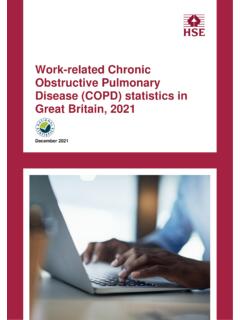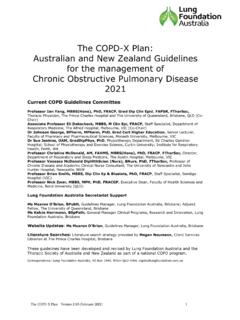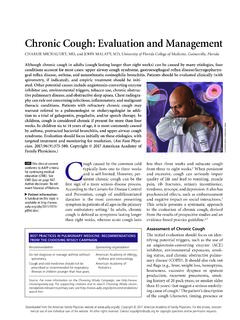Transcription of Guideline on clinical investigation of medicinal products in the ...
1 21 June 2012. EMA/CHMP/483572/2012 -corr1. Respiratory Drafting Group Guideline on clinical investigation of medicinal products in the treatment of chronic obstructive pulmonary disease (COPD). Draft Agreed by Efficacy Working Party (EWP) 6 July 2010. Adopted by CHMP for release for consultation 22 July 2010. Start of public consultation 29 September 2010. End of consultation (deadline for comments) 1 March 2011. Agreed by Respiratory Drafting Group February 2012. Adopted by CHMP 9 July 2012. Date for coming into effect 1 September 2012. This Guideline replaces Points to Consider CPMP/EWP/562/98, 19 May 1999. Keywords chronic obstructive pulmonary disease (COPD), airflow obstruction, relief of symptoms, maintenance treatment, exacerbations. 1. correction related to a change on p. 4. 7 Westferry Circus Canary Wharf London E14 4HB United Kingdom Telephone +44 (0)20 7418 400 Facsimile +44 (0)20 7418 8416. E-mail Website An agency of the European Union European Medicines Agency, 2012.
2 Reproduction is authorised provided the source is acknowledged. Guideline on clinical investigation of medicinal products in the treatment of chronic obstructive pulmonary disease (COPD). Table of contents Executive summary .. 3. 1. Introduction .. 3. 2. 4. 3. Legal basis and relevant guidelines .. 4. 4. Main text .. 5. Patient characteristics and selection of Methods to assess Efficacy Strategy and design of clinical 11. Early studies .. 11. Therapeutic confirmatory 12. 15. Specific safety concerns .. 15. Extent of exposure and long-term safety data .. 16. Guideline on clinical investigation of medicinal products in the treatment of chronic obstructive pulmonary disease (COPD). EMA/CHMP/700491/2012. 2/17. Executive summary This Guideline is a revision of the CPMP Points to Consider on clinical investigation of medicinal products in the chronic Treatment of Patients with chronic obstructive pulmonary disease (COPD). (CPMP/EWP562/98).
3 It is intended to update this previous guidance with new scientific knowledge of the disease as stated in new and updated clinical guidelines and to revise the requirements for the clinical investigation of medicinal products for the treatment of COPD accordingly. The requirements for pivotal studies, consideration of the need for reversibility testing of pulmonary function in patients with COPD, primary and secondary efficacy variables in clinical studies and the potential role of biomarkers have been updated. 1. Introduction COPD is a preventable respiratory disorder characterised by airflow limitation, which is not fully reversible. The airflow limitation is usually progressive and is associated with an abnormal inflammatory response in the lungs to noxious particles or gases, primarily caused by cigarette smoking. Although COPD affects the lungs it is also associated with significant systemic consequences. It is estimated that approximately eight percent of the population have COPD and approximately ten percent of those over 40 years of age.
4 However the true prevalence of the disease is likely to be higher than this due to under-diagnosis and diagnosis delayed until the disease becomes clinically apparent and is then moderately advanced. COPD is the fourth leading cause of death in Europe and is expected to rise to third by 2020. Worldwide, cigarette smoking (both current and past smoking) is the most commonly encountered risk factor for COPD. COPD is characterised by chronic inflammation associated with remodelling of the airway, lung parenchyma and pulmonary arteries, which in turn, give rise to the pathophysiological findings in COPD. mucus hypersecretion and cilliary dysfunction, airflow limitation and hyperinflation, gas exchange abnormalities, pulmonary hypertension and systemic effects. The chronic airflow limitation seen in COPD is caused by a mixture of small airway disease ( chronic obstructive bronchitis) and parenchymal destruction (emphysema), with the relative contribution of each varying from person to person.
5 COPD is a heterogeneous disease in terms of its clinical presentation, disease severity and rate of disease progression. Some patients have few complaints but an extremely sedentary lifestyle; others describe chronic respiratory symptoms ( dyspnoea on exertion and cough); some patients present with an acute exacerbation ( wheezing, cough and dyspnoea). Intermittent exacerbations of COPD, which represent an exacerbation of the inflammatory response, can be caused by exposure to infection (viral, bacterial) or to environmental pollutants. Weight loss, nutritional abnormalities, skeletal muscle dysfunction, cardiovascular effects, anaemia, systemic inflammation, mental dysfunction are well-recognised extrapulmonary symptoms and signs of COPD. Patients with COPD are at increased risk of myocardial infarction, angina, respiratory infections, osteoporosis, bone fractures, diabetes, depression, sleep disorders, glaucoma and anaemia.
6 COPD and its comorbidities cannot be cured and therefore must be treated on a chronic basis. The ultimate goal of treatment in COPD is to improve overall survival. Although much of the damage is irreversible at the time of clinical presentation, early diagnosis and appropriate management can prevent and improve symptoms (particularly dyspnoea), reduce the frequency and severity of exacerbations, improve health status and improve exercise capacity. At present no treatment has been shown to modify the rate of decline in lung function or to improve overall survival apart from smoking cessation. Guideline on clinical investigation of medicinal products in the treatment of chronic obstructive pulmonary disease (COPD). EMA/CHMP/700491/2012. 3/17. Since the disease is usually progressive, the overall approach to managing stable COPD involves a stepwise increase in treatment, depending on the severity of the disease . The most important step in treating COPD is to encourage smoking cessation.
7 Pharmacological therapies and non-pharmacological therapies should be added in a stepwise fashion depending on the severity of the disease and the clinical status of the patient. The mainstays of drug therapy for symptomatic relief in stable COPD are bronchodilators (primarily 2 agonists, anticholinergics and less often theophylline) and mucolytics and in more severe cases, long-acting 2 agonists (LABA) or long-acting muscarinic antagonists (LAMA)2. with or without inhaled corticosteroids (ICS) concomitantly or in combination. Recently, anti- inflammatory drugs with a new mechanism of action PDE-4 inhibitors, have been shown to have a role in severe COPD. Triple therapy ( LABA + ICS + an anticholinergic) might also be considered for certain patients. Supplemental therapies, such as oxygen, pulmonary rehabilitation and physiotherapy, immunisations, nutrition and exercise also play an important role in the management of COPD.
8 2. Scope This document is intended to provide guidance for the clinical evaluation of new medicinal products for the treatment of COPD, new products which may provide symptomatic relief through improvement of airway obstruction, which may modify or prevent exacerbations or which may modify the course of the disease or modify disease progression. However specifically, this Guideline will focus on the maintenance treatment of COPD. This Guideline will not focus on treatment of exacerbations. 3. Legal basis and relevant guidelines This Guideline has to be read in conjunction with the introduction and general principles (4) and parts I. and II of the Annex I to Directive 2001/83/EC as amended. Applicants should also refer to other relevant European and ICH guidelines (in their current version) on the conduct of clinical development, especially those on: Dose-Response Information to Support Drug Registration CPMP/ICH/378/95 (ICH E4).
9 Note for Guidance on Studies in Support of Special Populations: Geriatrics (ICH Topic E 7) and the Questions and Answers - EMEA/CHMP/ICH/604661/2009;. Statistical Principles for clinical Trials - CPMP/ICH/363/96 (ICH E9);. Choice of Control Group in clinical Trials - CPMP/ICH/364/96 (ICH E10);. Population exposure: The Extent of Population Exposure to Assess clinical Safety for Drugs - CPMP/ICH/375/95 (ICH E1A);. Guideline on the investigation of drug interactions - CHMP/EWP/125211/2010. Guideline on the Requirements for clinical Documentation for Orally Inhaled products (OIP). Including the Requirements for Demonstration of Therapeutic Equivalence Between Two Inhaled products for Use in the Treatment of Asthma and chronic obstructive pulmonary disease (COPD). in Adults and For Use in the Treatment of Asthma in Children and Adolescents - CPMP/EWP/4151/00 Rev. 1;. CPMP Note for Guidance on the clinical investigation of medicinal products in the Treatment of Asthma - CPMP/EWP/2922/01.
10 2. corr: a reference to LAMA has been included under the Introduction section as an alternative to LABA in combination with ICS for the most severe patients to make it consistent with the rest of the Guideline . Guideline on clinical investigation of medicinal products in the treatment of chronic obstructive pulmonary disease (COPD). EMA/CHMP/700491/2012. 4/17. Guideline on Missing Data in Confirmatory clinical Trials - CPMP/EWP/1776/99 ;. Guideline on clinical Development of Fixed Combination medicinal products - CPMP/EWP/240/05. This Guideline is intended to assist applicants during the clinical development of medicinal products . 4. Main text Patient characteristics and selection of patients Diagnosis of COPD should be considered in any patient who has symptoms of cough, sputum production or dyspnoea or a history of exposure to risk factors for the disease , particularly tobacco smoking. COPD is confirmed when a patient who has persistent or recurrent symptoms that are compatible with COPD ( chronic cough, chronic sputum production, dyspnoea) is found to have airflow obstruction that is not fully reversible ( post-bronchodilator forced expiratory volume in one second to forced vital capacity ratio (FEV1/FVC) less than (according to The Global Initiative for chronic obstructive Lung disease (GOLD) or below the lower limit of normal (LLN) in patients over 60 years of age (according to ATS/ERS guidelines) and there is no alternative explanation for the symptoms and airflow obstruction.))
















